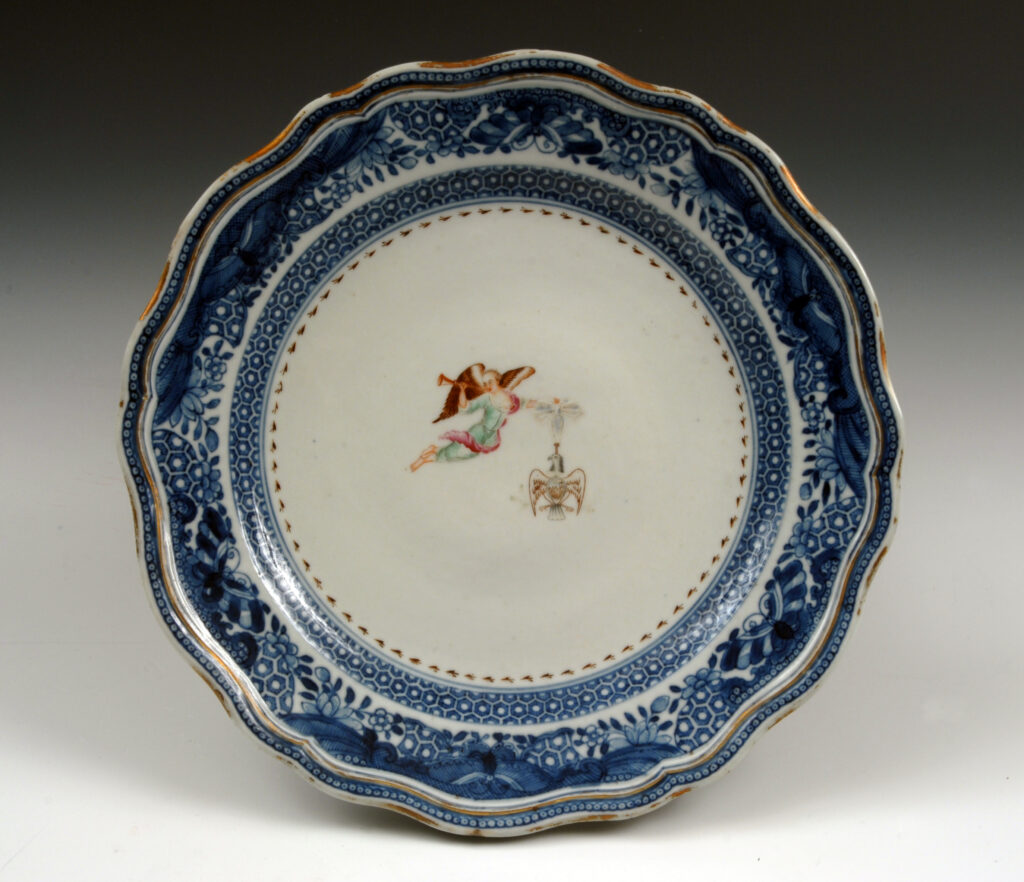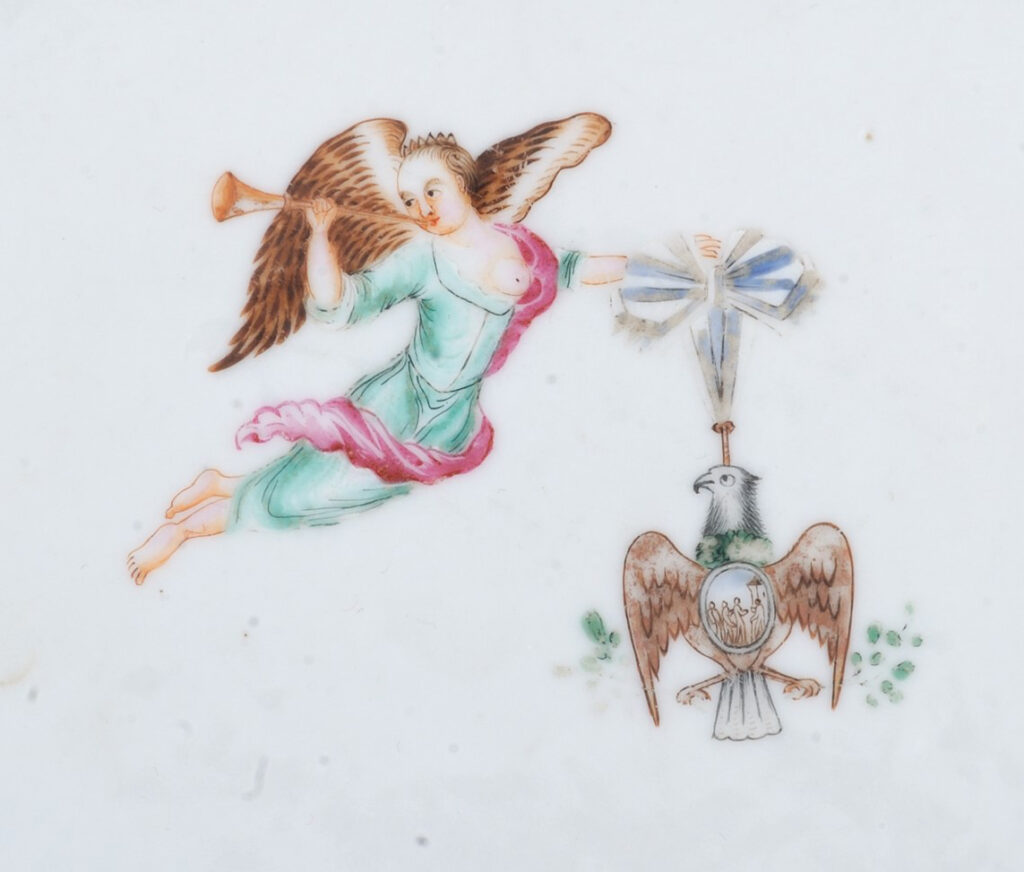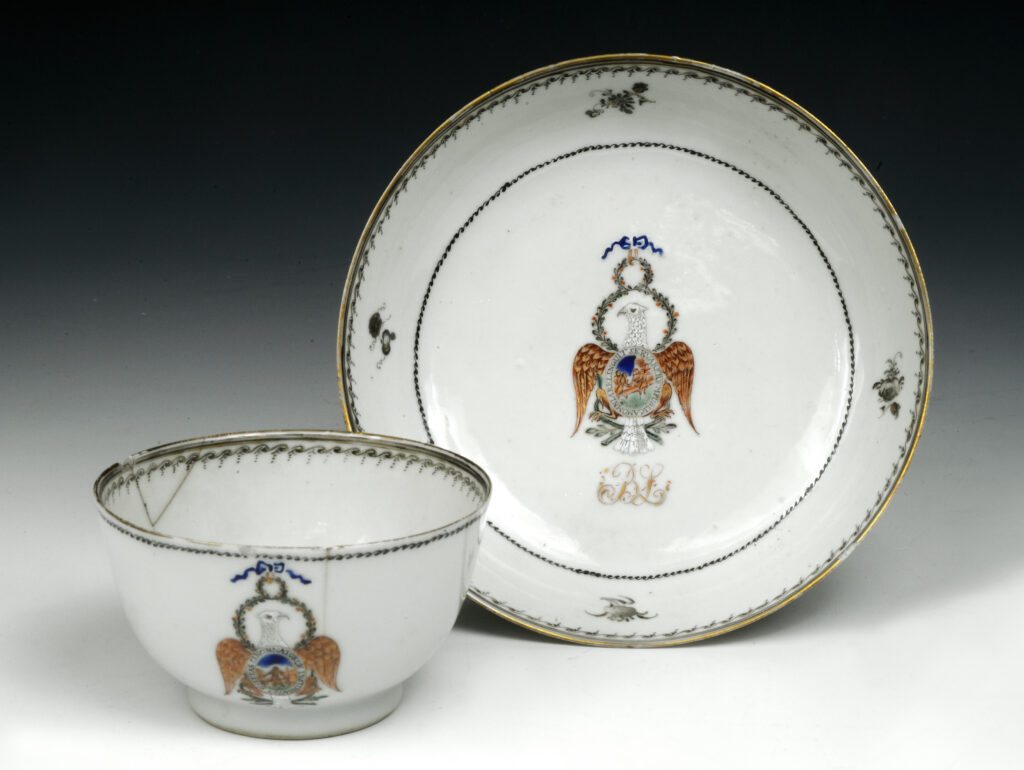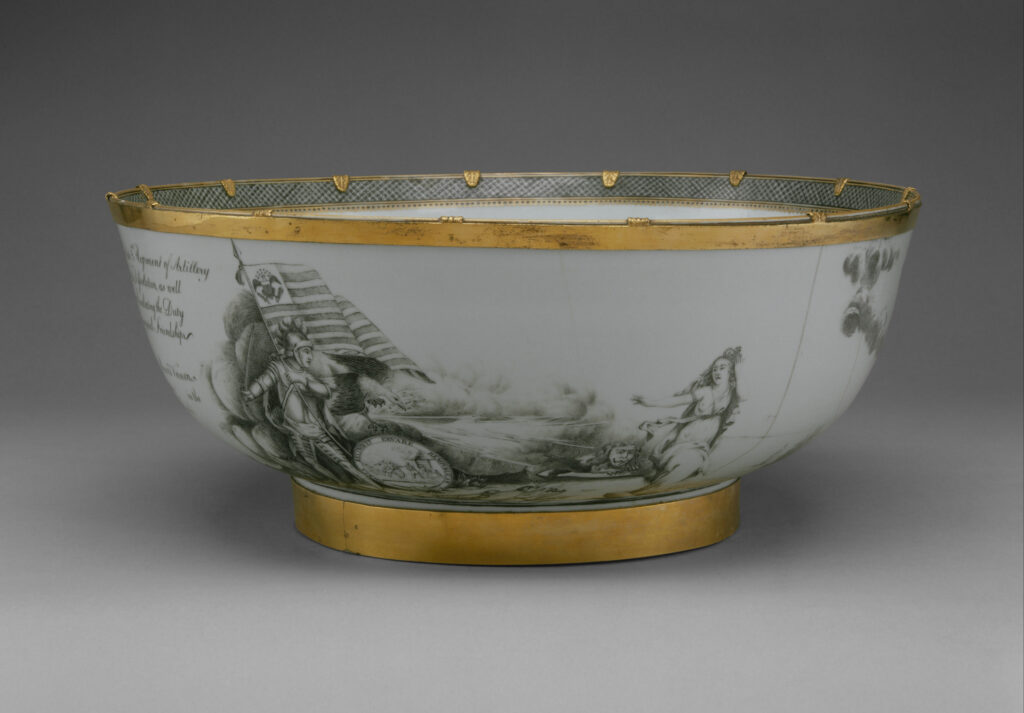The Society of the Cincinnati Chinese Export Porcelain
This article is adapted from “The Society of the Cincinnati Chinese Export Porcelain” by Lindsay E. Borst published in Cincinnati Fourteen 48, no. 2 (Spring 2012): 14-23.

Chinese export porcelain bearing the Eagle insignia of the Society of the Cincinnati is among the rarest forms of porcelain, prized by museums and collectors around the world. Of the recognized patterns of Cincinnati porcelain, perhaps the best known are the blue-and-white bordered dinner and tea services owned by George Washington and the tea services inscribed with their owners’ initials made for members of the Massachusetts Society. But there are several other unique designs made for individual services about which less is known. The Society’s museum collections contain nine pieces of this important porcelain—artifacts of the burgeoning relationship between China and America, the early history of the Society of the Cincinnati, and the lives of the distinguished men who owned them.
The central character in the story of the Cincinnati porcelain is Samuel Shaw, an original member of the Massachusetts Society of the Cincinnati and a prominent figure in the China trade. Shaw was born in Boston on October 2, 1754. At the beginning of the Revolutionary War, he joined William Heath’s Massachusetts regiment in May 1775 and was aide-de-camp to Gen. Henry Knox during the final year of the war. Shaw served as secretary of the committee of officers who formed the Society of the Cincinnati on May 13, 1783. Returning to civilian life, Shaw turned to commerce to resolve his debts and make his fortune. In December 1783, he agreed to sail to China as the agent of merchants Robert Morris of Philadelphia and Daniel Parker of New York. Shaw proved a capable negotiator. He made four trips to China over eleven years. He served as the new nation’s first consul to China from 1786 to his death in 1794. Shaw arranged the production of Cincinnati porcelain on at least three visits to China.
On February 22, 1784, the Empress of China, the first American ship in trade directly with China, embarked on the long voyage from New York to Canton (Guangzhou). Congress had just ratified the Treaty of Paris, and the passengers and crew must have begun the journey in a spirit of enthusiastic patriotism. Samuel Shaw was aboard as the ship’s agent, or supercargo, charged to act on behalf of Morris and Parker, who were eager to profit from trade with the Far East. The Chinese were equally interested in reaching the American market. American demand promised to revitalize the declining market for Chinese porcelain, which was facing stiff competition from European manufacturers. The Empress of China carried a cargo of ginseng, furs, lead, and silver. Shaw was to purchase tea, silk, lacquerware, and ivory, as well as porcelain, and in particular, “something emblematic of the institution of the order of the Cincinnati executed upon a set of porcelain.”[1] No evidence has been found that he had any particular buyers in mind for the first services or any specific direction from Society officers. He obtained a drawing of the Society’s Eagle insignia prior to his first voyage, perhaps from Pierre-Charles L’Enfant, who designed the insignia and the Society membership certificate.
The Society of the Cincinnati porcelain memorializes the patriotism, loyalty, and dedication of the members of the 'one Society of Friends' who owned it.
The Empress of China arrived in Canton on August 28, 1784. For much of the eighteenth and early nineteenth centuries, Canton was the only Chinese port where westerners could conduct business. European and the fewer American merchants and agents were restricted to a very narrow area along the banks of the Pearl River where business was conducted in hongs, or business houses. Most of the porcelain sold in Canton was made in Jingdezhen, some four hundred miles to the northwest in what may have been the largest industrial complex in the world at the time.
Chinese porcelain was valued for its high quality and delicate characteristics and had long been popular and fashionable in Europe and the United States. The hard-paste porcelain was made with kaolin—a pure white clay—and crushed quartz, which made it smooth and translucent white. The porcelain was shaped, fired, and glazed in Jingdezhen, where border decorations were often applied. When the porcelain arrived in Canton, often several months later, the foreign merchants and ships’ agents could arrange for more detailed decoration, like the Society’s insignia, to be added. Chinese painters and enamellers working among the hongs could create designs particular to their client’s exact specifications.
The most famous and recognizable examples of Cincinnati porcelain are from the first pattern produced in late 1784 or early 1785 and purchased by George Washington, the Society’s first president general. These pieces were executed in the fashionable and ubiquitous blue-and-white Fitzhugh border pattern of elaborate and whimsical flowers, butterflies, and other Chinese motifs. Thomas Fitzhugh, an official of the British East India Company, ordered a porcelain service with this border design in 1780, and his name became identified with this border. Porcelain services with the Fitzhugh border were so popular that Chinese artists in Jingdezhen and Canton kept it in stock, ready to be embellished with armorial or other designs when they were commissioned. The central overglaze decoration of the Cincinnati design, however, sets it apart from all others.

Shaw was responsible for the design of the central figure on the porcelain. He brought with him on the voyage several engravings and drawings from which the Chinese painters in Canton could work. He described his inspiration in his journal: "My idea was to have the American Cincinnatus, under the conduct of Minerva, regarding Fame, who, having received from them the emblems of the order, was proclaiming it to the world. For this purpose I procured two separate engravings of the goddesses, an elegant figure of a military man, and furnished the painter with a copy of the emblems, which I had in my possession."[2]
Shaw also appears to have also travelled with one of Pierre L’Enfant’s original sketches for the insignia. (L’Enfant would not return from Paris with the first gold insignias until late April 1784, several months after Shaw departed for Canton.) The final design was much simpler than Shaw described. He explained that the Chinese enameller “was unable to combine the figures with the least propriety…I could therefore have my wishes gratified only in part.”[3] In the final design, only the winged figure of Fame appears, wearing a green robe and rose-colored drape and blowing her horn while holding the Eagle insignia suspended from a blue-and-white ribbon.
Shaw departed Canton aboard the Empress of China on December 28, 1784, and arrived in New York on May 11, 1785, with sixty-four tons of porcelain—a testament to the popularity of Chinese porcelain in the new nation. The first Cincinnati porcelain arrived several months later in Baltimore aboard the Pallas, the second American ship to travel to China—Shaw had purchased a quantity of porcelain so great that it could not fit on the Empress of China alone. The Cincinnati porcelain was advertised in the Maryland Gazette & Baltimore Advertiser on August 12, 1785. The public announcement caught the attention of George Washington, who wrote to his former aide-de-camp and fellow Society member Tench Tilghman in Baltimore that he wanted to acquire a set of the porcelain. If it were to be sold at auction, the thrifty Washington noted, “bargains may be expected.” Tilghman responded that the prices in Baltimore had been set so high that they exceeded that of imported patterned china in area shops.[4] With no takers at those prices, the entire lot of Cincinnati porcelain was sent to New York and offered for sale the following year.
In July 1786, Henry “Light Horse Harry” Lee, an original Society member then serving as a delegate to the Continental Congress in New York, wrote to Washington that the porcelain was available for purchase and that a dinner and tea service of 302 pieces could be acquired for approximately $150—made “doubly valuable & handsome” by the presence of the Society insignia.[5] Washington instructed Lee to complete the transaction and purchased the service from the New York firm Constable, Rucker, & Co. The china arrived at Mount Vernon by October 31, 1786—“without much damage,” Washington noted—after a trip by sea from New York to Norfolk and then presumably up the Potomac River.[6] The Society’s museum collections include three dinner plates and one platter of this first design of Cincinnati porcelain.
Samuel Shaw returned to Canton on August 15, 1786, having been appointed United States consul to Canton earlier that year. By this time, he had received his gold Eagle insignia and was better able to instruct the Chinese enamellers in producing a more exact depiction of the insignia. Between 1786 and 1790—during his second or third trips to China—Shaw commissioned a dinner and a tea service for himself and at least nine tea services for fellow Massachusetts Society members decorated with the Society insignia.

The Cincinnati porcelain of this second design has a plain white background, and the extremely detailed Eagle insignia is painted with green, blue, red, and brown enamels with gilt highlights. There is no wide blue-and-white Fitzhugh border. Instead, a thin gilt and black enamel wave-like border runs around the rim. Unlike the Washington service, the Eagle appears without the figure of Fame and with a double wreath of green foliage with red berries encircling the Eagle’s head. Both the obverse and reverse of the insignia—bearing different scenes from the life of Cincinnatus, the Society’s namesake—appear on many of the larger pieces of these tea services. A receipt dated January 3, 1791, indicates that Shaw paid twenty dollars for the shipment of nine of these tea services to America.[7] Not all of the recipients have been identified, but they include Henry Jackson, William Eustis, Benjamin Lincoln, Constant Freeman, David Townsend, and Henry Knox. The sets are each personalized with the owner’s initials, or cipher, painted in gold script. One deviation is the cipher on Knox’s set—“HLK”—which combines his wife Lucy’s initials with his own.
Shaw transmitted one of these tea services to his friend Dr. David Townsend with a letter written on December 20, 1790, while Shaw was in Canton during his third trip: "Accept, my dear friend, as a mark of my esteem and affection, a tea set of porcelain, ornamented with the Cincinnati and your cipher. I hope shortly after its arrival to be with you, and in company of your amiable partner, see whether a little good tea improves or loses any of its flavor in passing from one hemisphere to the other." Below the signature, Shaw listed the forty-five pieces that comprised the tea service: two teapots, two teapot stands, sugar bowl and stand, milk ewer, bowl and dish, six breakfast cups and saucers, and twelve afternoon cups and saucers.[8] The services owned by Shaw and Knox, however, were considerably larger and included several additional forms. Thirty-eight pieces of Townsend’s service survive in the collections of Historic Deerfield in Deerfield, Massachusetts, and more than thirty pieces of Benjamin Lincoln’s service are in the collections of the Concord Museum in Concord, Massachusetts. The Society’s own collections include five pieces from these tea services—two saucers and a teacup from Lincoln’s service and a sugar bowl and creamer from Shaw’s service.
There are three additional unique designs for Cincinnati porcelain. Much less is known about their origins. It is unclear if Samuel Shaw was involved in their design and purchase, or if their owners commissioned the services or only learned of them when they were advertised for sale in America. William Eustis, who served as vice president of the Massachusetts Society from 1786 to 1810 and again in 1820, owned an unusual second set of Cincinnati porcelain in addition to the tea service he received from Shaw. Distinctive from all other known designs, pieces from this service are decorated with two figures of Fame holding the Society insignia suspended from a voluminous blue-and-white ribbon. The Eagle appears to have been rendered from a combination of sources, with the head and surrounding wreath taken from the gold insignia and the wings and talons more resembling the earlier L’Enfant drawing of the insignia. A simple, thin blue border with gold stars surrounds each piece. Examples from this service are incredibly rare and are held in the collections at Winterthur and in private collections. Several specialized forms, including coffee cups, suggest that this service was likely a tea and coffee set numbering fifty pieces or more. It dates from about 1785, suggesting it may have been ordered and produced during Shaw’s second trip to China.
Another distinctive design of Cincinnati porcelain was owned by Richard Humpton, an original member of the Pennsylvania Society. On each piece of this service, the Eagle insignia is suspended from a blue ribbon with both encircled by a wreath of green leaves. The simple borders consist of a green saw-tooth pattern around the gilt rim and a secondary border of undulating green leaves below. The exact date of this service is not known, but the similarities between this Eagle design, the original L’Enfant drawing of the insignia, and the Eagle design on Washington’s Cincinnati service suggest that it was among the first sets manufactured.

Perhaps the most striking pieces of Cincinnati porcelain are the extraordinary punch bowls owned by Ebenezer Stevens and Richard Varick, both original members of the New York Society, dated between 1786 and 1790. These bowls, measuring approximately sixteen inches in diameter, are decorated with detailed facsimiles of the Society’s membership certificate signed by Henry Knox and George Washington. The theatricality of L’Enfant’s original diploma design is captured in the allegorical figures of Fame trumpeting the victory of liberty from the clouds and Britannia cowering before the armored American Cincinnatus—images that Chinese artists copied from an original parchment certificate. The polychrome Varick bowl is in the collections of Morristown National Historic Park in New Jersey. The Stevens bowl, at the Metropolitan Museum of Art in New York, is executed in black and white, but nonetheless exhibits a virtuosity of craftsmanship and artistic ability. The underside of the Stevens bowl is inscribed “Syngchong,” the same name as the Chinese business associate who Samuel Shaw regarded as the “principle porcelain merchant at Canton.”[9]
Shaw did not return to America at the end of the 1790 trading season as planned. He returned from his third voyage to China the following year and was on his way west from Bombay by January 1792. Shaw traveled to China for the fourth and final time in February 1793, just six months after his marriage to Hannah Phillips. He arrived in Canton on November 2, 1793, but was soon afflicted by a “disease of the liver incident to the climate.”[10] He departed Canton on March 17, 1794—months before he had planned—and died at sea aboard the Washington off the Cape of Good Hope on May 30, 1794.
The Society of the Cincinnati Chinese export porcelain will remain among the most important artifacts of the late-eighteenth century trade between China and the newly independent United States of America. In all of its beautiful renditions, the porcelain memorializes the patriotism, loyalty, and dedication of the members of the “one Society of Friends” who owned it.
- Samuel Shaw, The Journals of Major Samuel Shaw, the First American Consul at Canton, ed. Josiah Quincy (Boston: Wm. Crosby and H. P. Nichols, 1847), 198-199. ↩
- Ibid., 198. ↩
- Ibid., 198-199. ↩
- George Washington to Tench Tilghman, August 17, 1785, and Tench Tilghman to George Washington, October 13, 1785, in The Papers of George Washington, Confederation Series, vol. 3 (Charlottesville: University Press of Virginia, 1994), 187-189, 305-306. ↩
- Henry Lee, Jr., to George Washington, July 3, 1786, in Papers of George Washington, Confederation Series, vol. 4 (Charlottesville: University Press of Virginia, 1995), 147. ↩
- Washington to Lee, October 31, 1786, in Papers of George Washington, Confederation Series, vol. 4, 320. ↩
- Shipping receipt, January 3, 1791, Samuel Shaw Papers, Massachusetts Historical Society, Boston. ↩
- Samuel Shaw to Dr. David Townsend, December 20, 1790, Historic Deerfield. ↩
- Shaw, Journals of Major Samuel Shaw, 198. ↩
- Ibid., 123. ↩